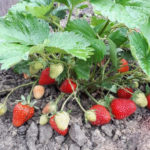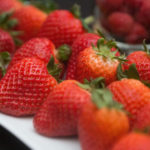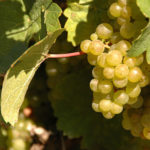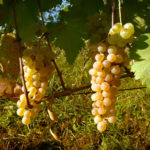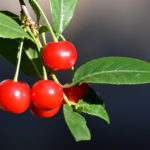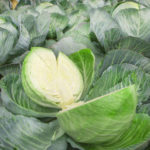Saperavi grape variety
Saperavi is an old Georgian technical variety of dark-colored grapes, which are widespread at present both in their homeland and in Russia, Ukraine, Moldova, Azerbaijan, Kazakhstan, Uzbekistan and some other countries. For Georgia, with its ancient winemaking traditions passed down from generation to generation, this is a legendary variety, its pride. Of the five hundred different varieties and hybrid forms that grow in the country, Saperavi occupies the largest area, being the main source of raw materials for the production of wonderful local red wines.
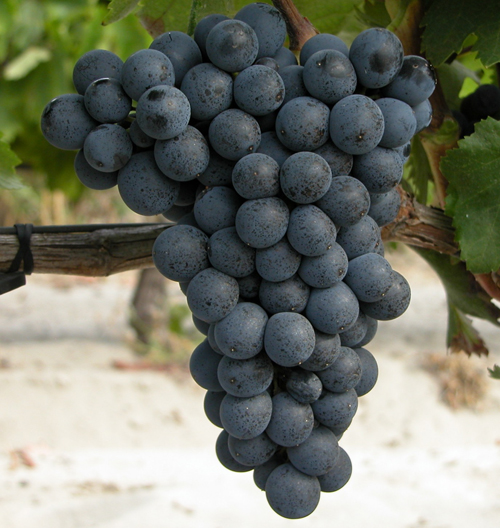
Unfortunately, information about the origin of our hero has not been preserved, however, scientists, based on the study of historical documents, do not abandon attempts to trace his history from the time of the first mention to the present day. In different regions of the country, numerous clones of the variety are widespread, which have long been called very diverse names, which, according to local researchers, is also evidence of its more than significant life path.
Without exaggeration, Saperavi can be called unique in its originality and variability of the opportunities that it provides to a skilled winemaker. Those who have worked with him invariably note his technological flexibility and plasticity. There is evidence of interesting experiments, when technologists and winemakers from different countries, working with grapes from the same area, with the same collection and sorting time, received wines that were strikingly different in organoleptic characteristics, each of which presented the variety in a completely unexpected light.
At the same time, the main and constant distinguishing feature of Saperavi is the stunningly rich color, characteristic of the wines made from it. Actually, it got its name from the word that means "paint" in Georgian. The intensity of pigmentation of wine from this grape is so high that if you dilute it with water twice, the color will not lighten a single tone. This remarkable quality is widely used by winemakers to enhance the color of many table, strong and dessert wines produced by the blending method. For this purpose, the variety, to a greater or lesser extent, is contained in such famous drinks as Negru de Purcari, Alazani Valley, Akhasheni, Kindzmarauli, Mukuzani, Pirosmani, Apsny, etc. Varietal wines are also quite common, however, due to their density and saturation, they reach their best qualities after a long exposure, at least 4 years.
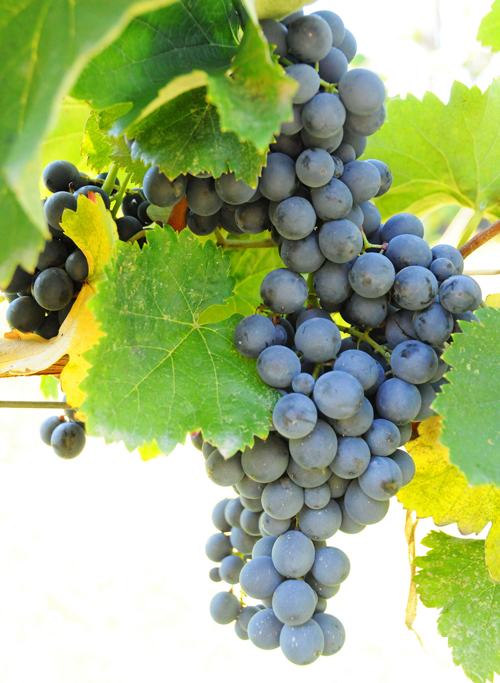
Saperavi passed on many of his outstanding qualities to descendants, of which, thanks to his active use by scientists in breeding work, there are a significant number. The most famous of them are: Ruby Maharacha, Bastardo Maharach, Jalita, Izobilny, Northern Saperavi.
The variety is widely zoned in the post-Soviet space. In Russia, grapes are included in the State Register of Breeding Achievements and approved for industrial cultivation in the North Caucasus (Republic of Ingushetia, Adygea, North Ossetia-Alania, Dagestan, Chechen, Crimea, Kabardino-Balkar, Krasnodar and Stavropol Territories, Rostov Region) and Nizhnevolzhsky ( Astrakhan, Saratov and Volgograd regions, Republic of Kalmykia) regions.
Agrobiological characteristics
The growth vigor of the bushes is average. The crown of a young shoot is almost white from tomentose pubescence, with noticeable pink stripes. Young leaves are greenish-yellow with a barely noticeable reddish tinge. The developed leaves are medium in size, round or ovoid, three- or five-lobed, slightly dissected, light green.The leaf blade is flat with slightly raised edges and often an elongated central lobe, its upper side is reticulate-wrinkled, the lower one is covered with dense cobweb pubescence. The upper lateral notches are of medium depth, open, lyre-shaped with a rounded bottom, the lower ones are much smaller, barely outlined, or have the shape of an inclined angle. The petiole notch is open, lyre-shaped or vaulted. The denticles along the edge of the vine leaves are large, triangular, with sharp tops and convex sides. In autumn, the foliage is yellow, with wine-red spots. Saperavi flowers are bisexual, but an unpleasant feature of the variety is its tendency to peel berries, as well as shedding flowers and ovary. The maturation of the annual growth is good (85%). Ripe shoots acquire a light brown color with a grayish tinge, in the nodes the color is several shades darker.
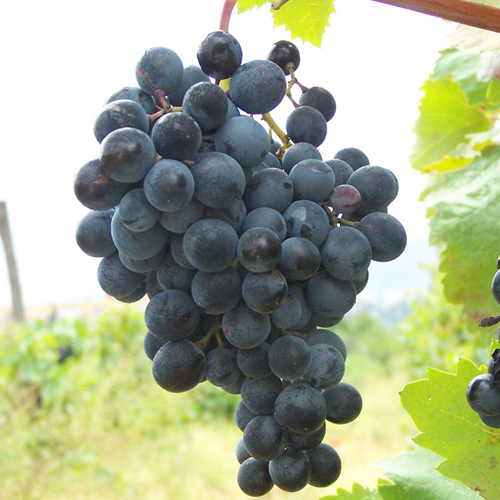
Bunches of medium size, from 13 to 17 cm in length, and 12-15 cm in width, with an average weight of 95-150 grams, broadly conical or branched, loose or medium density. Some brushes reach 170 grams or more. The comb is short, herbaceous, up to 4.5 cm long. The berries are medium, slightly oval, 14-18 mm long, 12-16 mm in diameter and weighing 1.2-1.5 grams. The pulp is pink, juicy, with a simple taste and slight sourness. Freshly squeezed grape juice is pleasant and fresh in taste, slightly colored, sugar content 17-21 grams / 100 cubic meters. cm and acidity 7.8-12.6 grams / cubic dm. Its yield is 80-85%. In the very south, especially in hot years, sugar accumulation can reach 23% and even 26-28%. The skin of the berries is thin, but strong, dark blue in color with a thick bloom of prune on the surface. There are 2-3 seeds in grapes, they occupy a small percentage of its volume.
The harvest is used in the wine industry as a raw material for the production of high-quality table, strong and dessert wines with stunning color saturation, as well as harmony and velvety taste and aroma. In the pearl of Georgian winemaking - Kakheti, where Saperavi wines are produced according to centuries-old traditional recipes, they are characterized by an intense dark pomegranate color, fullness and freshness of taste with a strong bouquet that develops every year of aging. In the south of Crimea, grapes show excellent indicators for the accumulation of sugars, in connection with which wonderful dessert drinks are obtained from them. Table wines from the variety at a young age can be somewhat rough in taste. Therefore, it is better to use varietal Saperavi aged for at least three to four years, and ideally 10-12 years, after which, according to oenologists, “his character hardens and matures”, and the wine itself becomes “thick and viscous”. The wine material, rich in color, is also very much appreciated when combined with other varieties, because the presence of even a tenth of our hero in the finished wine can significantly improve its color, extract and acidity.
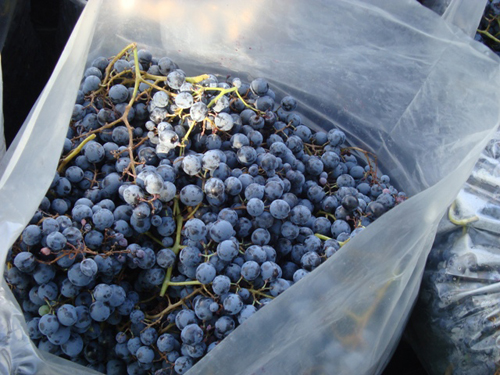
The grapes ripen at a later date - at the end of September, the first half of October. To achieve removable ripeness, it needs at least 2900-3000 ° C. The growing season from budding to the start of harvesting lasts 150-160 days. The productivity of plants is quite high - two-thirds of the shoots are fruitful, the average number of clusters per developed shoot is 0.88, and per fruitful - 1.63. Even shoots from replacement and dormant buds are productive, so that even frost-damaged bushes do not disappoint the growers. The yield is stable over the years and is usually 90-110 c / ha. Long-term presence of the crop on the bushes after ripening is possible only in regions with warm dry autumn. Rainy, damp weather, as well as autumn fogs, create ideal conditions for the defeat of grapes with gray rot, to which Saperavi does not shine. The frost resistance of the vine is average, without damage it tolerates winters with temperatures down to -20 ° C.
Agrotechnical features
Cultivation of a variety requires a competent approach, knowledge of its specifics and weaknesses in agrobiology.A variety of soil types are suitable for planting a vineyard, except for too dry sandy and stony, waterlogged, saline and excessively calcareous, which provoke chlorosis in bushes. Saperavi grows best and gives the most bountiful harvests on warm and well-lit southern and southwestern slopes with fertile, water- and air-permeable soils and a sufficient level of moisture. At the same time, in the steppe zone, the plants demonstrate sufficient drought resistance, which makes it possible to cultivate them in regions with unstable moisture.
The variety propagates usually in a grafted culture, since self-rooted grape seedlings are very susceptible to phylloxera. The best rootstocks are Riparia x Rupestris 101-14, Riparia x Rupestris 3309, and on soils with a high lime content - Chassela x Berlandieri 41B and Berlandieri x Riparia Kober 5BB.
The bushes are formed both on a high stem with one- and two-sided cordons and a free arrangement of one-year growth, and according to standard-free patterns, the main of which is a multi-arm fan. The determining factor when choosing a formation is the need to shelter the vines for the winter, which in turn depends on the nature of the climate in each particular area. Protection from winter frosts and a corresponding bush management scheme is required where there is a risk of lowering negative temperatures to critical values for the variety. In this case, the squat formation will allow you to easily remove the grape vine from the trellis in the fall and insulate it with improvised organic materials, be it reeds, straw or sawdust, followed by waterproofing the insulation with roofing material, film or wooden shields. On large areas, in the absence of the possibility to use special insulation materials, the covering of the above-ground part of Saperavi with a layer of earth shows good results.
The load on the bush during spring pruning is quite significant - 50-60 eyes per bush with the length of fruit arrows 6-9, or even 10-12 buds. In case of unfavorable overwintering and frost damage to the bush, it is advisable to reduce the total load by a third or even half to increase the ability of plants to recover from dormant and replacement buds. During the growing season of grapes, sterile, weak shoots, "twins" and "tees" break off in order to redirect nutrients to the formation of a bountiful harvest. Ideally, each plant should have 6-10 shoots or 8-14 bunches per square meter of feeding area. Insufficient use of the strength of the bush of this variety provokes the growth of stepchildren and coppice shoots, and in general the prevalence of the vegetative component over the generative one.
Saperavi demonstrates low resistance to fungal diseases. For its full growth and fruiting, a clear, effective and full-fledged strategy of combating pathogens in the vineyard is necessary, and first of all the most harmful of them - mildew, oidium and gray rot. In the case of this variety of grapes, one should not wait for the appearance of even the first signs of disease, the fight against them should be carried out proactively, and chemical treatments should be primarily preventive in nature and only in exceptional cases - therapeutic.
The variety responds very well to improving the agricultural background by regular watering and feeding with moderate doses of mineral fertilizers. This primarily affects the size and weight of the bunches, and as a result, the overall yield. In addition, good care has not only a direct, but also an indirect effect, expressed in strengthening the plants themselves, better preparation for the winter period: full maturation of one-year growth and the accumulation of more plastic substances in the tissues.
In principle, Saperavi can be attributed to the number of flexible and plastic grape varieties, not only from a technological, but also from an economic point of view. Long-term experience of its cultivation in various countries and climatic zones has shown its amazing versatility and the highest ability to adapt to new conditions. At the same time, the main distinctive properties of the variety, for which winemakers value it, are consistently bright, regardless of the place of growth.
